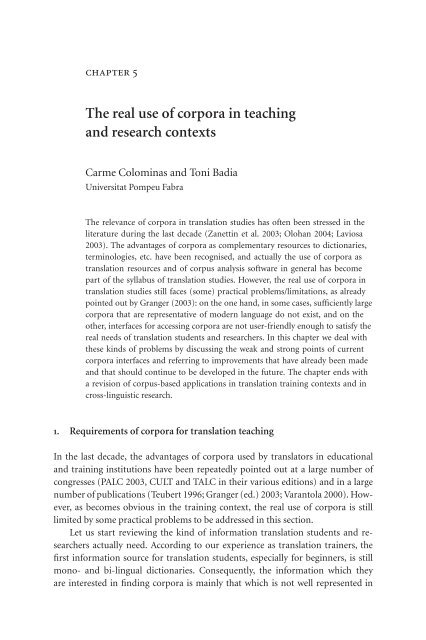Topics in Language Resources for Translation ... - ymerleksi - home
Topics in Language Resources for Translation ... - ymerleksi - home
Topics in Language Resources for Translation ... - ymerleksi - home
- No tags were found...
You also want an ePaper? Increase the reach of your titles
YUMPU automatically turns print PDFs into web optimized ePapers that Google loves.
chapter 5The real use of corpora <strong>in</strong> teach<strong>in</strong>gand research contextsCarme Colom<strong>in</strong>as and Toni BadiaUniversitat Pompeu FabraThe relevance of corpora <strong>in</strong> translation studies has often been stressed <strong>in</strong> theliterature dur<strong>in</strong>g the last decade (Zanett<strong>in</strong> et al. 2003; Olohan 2004; Laviosa2003). The advantages of corpora as complementary resources to dictionaries,term<strong>in</strong>ologies, etc. have been recognised, and actually the use of corpora astranslation resources and of corpus analysis software <strong>in</strong> general has becomepart of the syllabus of translation studies. However, the real use of corpora <strong>in</strong>translation studies still faces (some) practical problems/limitations, as alreadypo<strong>in</strong>ted out by Granger (2003): on the one hand, <strong>in</strong> some cases, sufficiently largecorpora that are representative of modern language do not exist, and on theother, <strong>in</strong>terfaces <strong>for</strong> access<strong>in</strong>g corpora are not user-friendly enough to satisfy thereal needs of translation students and researchers. In this chapter we deal withthese k<strong>in</strong>ds of problems by discuss<strong>in</strong>g the weak and strong po<strong>in</strong>ts of currentcorpora <strong>in</strong>terfaces and referr<strong>in</strong>g to improvements that have already been madeand that should cont<strong>in</strong>ue to be developed <strong>in</strong> the future. The chapter ends witha revision of corpus-based applications <strong>in</strong> translation tra<strong>in</strong><strong>in</strong>g contexts and <strong>in</strong>cross-l<strong>in</strong>guistic research.1. Requirements of corpora <strong>for</strong> translation teach<strong>in</strong>gIn the last decade, the advantages of corpora used by translators <strong>in</strong> educationaland tra<strong>in</strong><strong>in</strong>g <strong>in</strong>stitutions have been repeatedly po<strong>in</strong>ted out at a large number ofcongresses (PALC 2003, CULT and TALC <strong>in</strong> their various editions) and <strong>in</strong> a largenumber of publications (Teubert 1996; Granger (ed.) 2003; Varantola 2000). However,as becomes obvious <strong>in</strong> the tra<strong>in</strong><strong>in</strong>g context, the real use of corpora is stilllimited by some practical problems to be addressed <strong>in</strong> this section.Let us start review<strong>in</strong>g the k<strong>in</strong>d of <strong>in</strong><strong>for</strong>mation translation students and researchersactually need. Accord<strong>in</strong>g to our experience as translation tra<strong>in</strong>ers, thefirst <strong>in</strong><strong>for</strong>mation source <strong>for</strong> translation students, especially <strong>for</strong> beg<strong>in</strong>ners, is stillmono- and bi-l<strong>in</strong>gual dictionaries. Consequently, the <strong>in</strong><strong>for</strong>mation which theyare <strong>in</strong>terested <strong>in</strong> f<strong>in</strong>d<strong>in</strong>g corpora is ma<strong>in</strong>ly that which is not well represented <strong>in</strong>
















